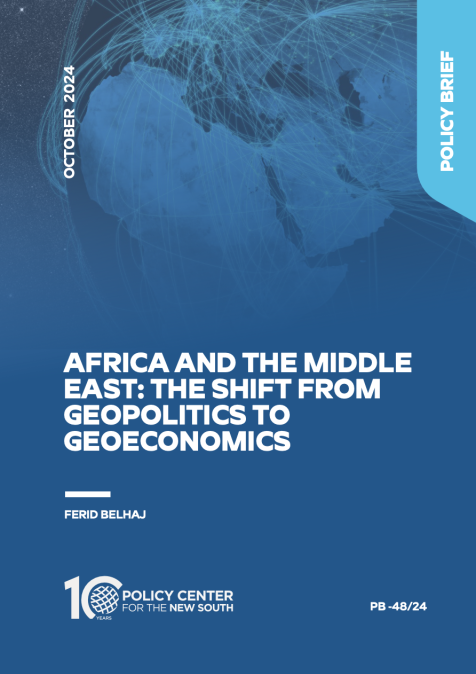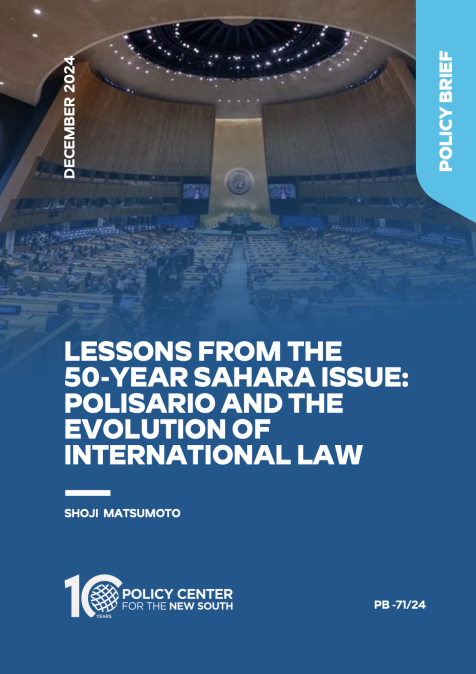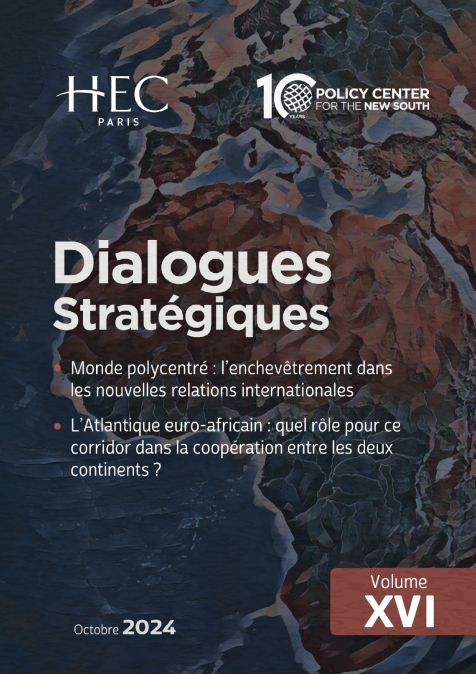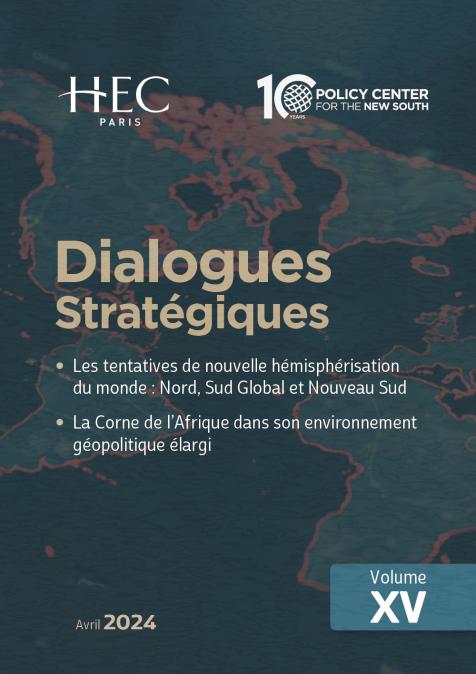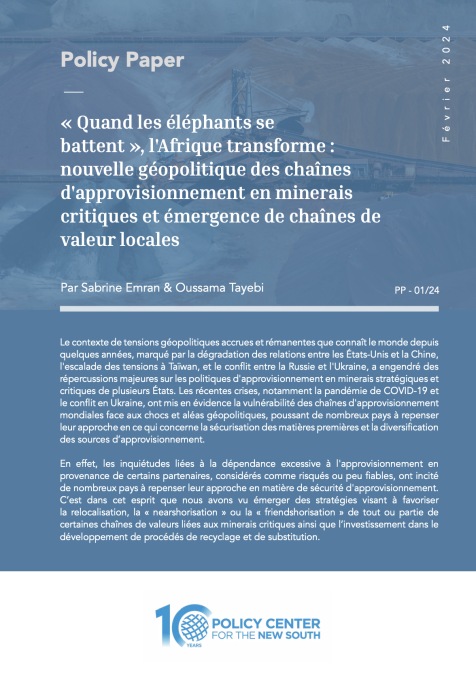Publications /
Policy Brief
In an era marked by shifting global dynamics, Africa and the Middle East are experiencing a profound transition from traditional geopolitics to a more nuanced geoeconomic framework. This evolution reflects the growing recognition that economic interests, rather than mere political allegiances, are driving international relations in these regions. The rise of emerging powers, particularly China and other Asian nations, has challenged the long-standing dominance of Western economies, offering alternatives that prioritize infrastructure development and trade over political conditionality. As governments in Africa and the Middle East seek to maximize their economic potential, they are increasingly inclined to engage in partnerships that enhance their sovereignty and promote self-reliance. The implications of this shift are profound, heralding a new chapter in international cooperation in which economic collaboration is viewed as the pathway to stability and growth. This paper explores the ramifications of this transition, examining how the focus on geoeconomics is reshaping diplomatic ties, investment flows, and regional integration initiatives. It argues that this paradigm shift not only empowers Africa and the Middle East, but also redefines the global landscape, as these regions assert themselves as key players in the emerging multipolar world.
Introduction
In the post-Cold War era, the Middle East and Africa were defined largely by their geopolitical significance. The West, especially the United States and Europe, engaged with these regions through a lens focused on security, energy supply, and strategic alliances. However, this dynamic has shifted significantly over the last two decades. The global economic center of gravity has been moving steadily eastward, driven by China’s meteoric rise and Asia’s broader economic resurgence. This shift has reoriented the priorities of many Middle Eastern and African nations, where economics now overshadows traditional geopolitical concerns.
The transition from geopolitics to geoeconomics is not merely a shift in priorities, but a fundamental restructuring of how nations in these regions navigate global power structures.
While security concerns, such as conflicts in Syria, Yemen, and the Sahel, continue to dominate headlines, many governments in the Middle East and Africa are pursuing economic partnerships that promise sustainable development and long-term growth. The old reliance on Western military alliances and energy dependence is giving way to new relationships centered around infrastructure development, trade agreements, and investment flows.
China’s Belt and Road Initiative (BRI), launched in 2013, has been a cornerstone of this geoeconomic pivot. Through the BRI, China has committed billions of dollars in investments across the Middle East and Africa. BRI projects range from building railways and ports in East Africa, to developing energy pipelines and high-tech zones in the Gulf. The World Bank estimates that by 2025, BRI-related investments could lift more than 7.6 million people out of extreme poverty, and 32 million people out of moderate poverty, underscoring the BRI’s significance as an economic catalyst (Maliszewska and van der Mensbrugghe, 2019).
Africa in particular has seen significant impacts from this new geoeconomic focus. By 2023, China had become Africa’s largest trading partner, with trade volumes exceeding $282 billion. In countries including Ethiopia, Kenya, and Nigeria, Chinese investment has transformed infrastructure, leading to the building of new highways, airports, and industrial zones that have helped fuel economic growth. This stands in stark contrast to Western aid, which often comes with conditionalities tied to governance reforms and human rights benchmarks.
In the Middle East, China’s in involvement has been equally transformative. Countries including Saudi Arabia, the UAE, and Egypt have deepened their economic ties with Beijing through the development of renewable energy projects and collaboration on advanced technologies such as artificial intelligence and 5G infrastructure. In 2021, Chinese companies secured major contracts to develop solar and wind energy farms in the Gulf region, signaling a pivot toward renewable energy in a part of the world historically defined by oil.
This geoeconomic shift also marks a growing diversification of foreign policy by Middle Eastern and African nations. While Western powers remain key partners, these countries are no longer exclusively reliant on the U.S. and Europe for their development needs. By aligning themselves with China and other emerging Asian powers, they are creating a more multipolar landscape that offers greater autonomy and bargaining power.
China and the West: A New Geopolitical Contest
While the geoeconomic pivot to China has brought numerous benefits to the Middle East and Africa, it is also fueling a new geopolitical contest. In many Western countries, China’s growing influence is viewed with increasing alarm. The U.S., in particular, has expressed concerns over what it sees as Beijing’s ‘debt-trap diplomacy’, with Chinese loans to developing countries perceived as tools of political leverage. Countries including Sri Lanka and Zambia have experienced financial difficulties in repaying Chinese loans, raising concerns about the long-term sustainability of such arrangements.
The Western response to China’s economic diplomacy has been largely reactive. In 2021, the G7 nations announced a new initiative titled Build Back Better World (B3W), which aims to provide an alternative to the BRI by investing in infrastructure projects in low- and middle-income countries. However, the B3W has been slow to materialize, and its funding pales in comparison to the scale of China’s investments. B3W's stricter standards will result in greater public scrutiny, higher up-front costs, and longer timelines, making it less competitive. Without direct funding mechanisms, B3W is also less streamlined. This underscores the broader challenge facing Western nations: competing with China in the economic domain requires more than just rhetorical opposition; it demands tangible investments and long-term commitments.
In the Middle East and Africa, many governments are wary of becoming pawns in a new Cold War between the U.S. and China. Rather than choosing sides, they seek to balance their relationships with both powers, leveraging their economic importance to extract concessions from each. This balancing act is most evident in the Gulf region, where countries such as Saudi Arabia and the UAE have maintained close security ties with the U.S. while expanding their economic partnerships with China. Similarly, African nations seek to engage with both Western and Eastern powers to maximize the benefits of foreign investment.
The Gulf’s Strategic Slow-Motion Pivot Towards China and Asia
Among the most notable shifts in geoeconomic strategies in recent years has been the growing orientation of the Gulf Cooperation Council (GCC) countries towards China and Asia. Traditionally close allies of the West, especially the United States, Gulf nations including Saudi Arabia, the UAE, and Qatar are increasingly turning eastward in pursuit of diversified economic partnerships, reduced dependence on oil revenues, and access to new markets for their goods and services.
At the heart of this slow-moving pivot is the deepening relationship with China, which has rapidly become the region’s top trading partner. Trade between the GCC and China has grown exponentially, surpassing $180 billion in 2021, with expectations of reaching $300 billion by 2030. This trade is no longer limited to oil exports from the Gulf; it has expanded to include infrastructure projects, digital economy collaborations, and renewable energy partnerships. For instance, Saudi Arabia’s Vision 2030, which aims to reduce its economic dependence on oil, aligns well with China’s BRI, opening up avenues for Chinese investments in Saudi Arabia’s ambitious infrastructure and industrial projects, including the futuristic megacity Neom.
The UAE, long seen as a global trade hub, has similarly positioned itself as a key node in China’s BRI ambitions. In 2021, Chinese companies secured high-profile contracts in the UAE, including the development of the Khalifa Port, a vital logistics hub that facilitates trade between China, the Middle East, and Africa. The UAE’s free trade zones and strategic location between Asia, Africa, and Europe make it an attractive partner for China’s aspiration to connect global markets through the BRI.
At the same time, Gulf nations are not aligning exclusively with China. They are broadening their economic engagements across Asia, particularly with countries such as India, South Korea, and Japan. The UAE has pursued extensive investments in India’s tech and energy sectors, while Saudi Aramco has signed multiple deals with Indian refineries as part of its strategy to ensure stable demand for its oil exports in the long run. Similarly, Japan and South Korea are emerging as critical partners in Gulf nations’ efforts to transition towards renewable energy, with joint ventures being established in hydrogen production and green technologies.
This eastward economic move marks a significant departure from the traditional West-centric alignment that defined Gulf foreign policy throughout the twentieth century. While security partnerships with the United States and European nations remain intact, the GCC countries are making it clear that their economic futures also lie with the East. This diversification is not just driven by economic factors; it reflects a broader desire for greater strategic autonomy in an increasingly multipolar world.
The recent visit of UAE President Sheikh Mohamed bin Zayed to the United States underscored the Gulf nation’s growing ambition to deepen strategic ties with Washington, particularly in the realms of AI and climate cooperation. During the visit, discussions centered on advancing partnerships in cutting-edge technologies, with the UAE positioning itself as a hub for AI innovation. The UAE’s proactive stance on climate, evidenced by its hosting of COP28, aligns with the Biden Administration’s climate goals, reinforcing both nations’ shared commitment to sustainability. This visit also highlighted the UAE’s intent to transition from its traditional energy-based economy to a future shaped by green technologies and digital transformation.
However, while the UAE’s push to deepen relations with the U.S. on AI and climate technology suggests a strategic alignment with Washington, it doesn’t necessarily indicate an intention to play China and the U.S. against each other. Instead, it reflects the UAE’s broader strategy of balancing global partnerships. By strengthening ties with both the U.S. and China, the UAE seeks to leverage the best of both worlds—harnessing Western technological expertise while benefiting from China’s fast-growing AI and renewable energy sectors. This pragmatic approach allows the UAE to position itself as a global innovation hub without being locked into exclusive alliances, keeping its options open in a multipolar world.
The Gulf’s outreach to China and Asia is a pragmatic response to the global realignments currently underway. As the West’s influence wanes in some regions and China’s economic power grows, Gulf nations are positioning themselves to benefit from these tectonic shifts. However, they are also mindful of the risks involved. As these nations deepen their ties with China, they are also careful to navigate the emerging geopolitical contest between the West and China, ensuring that their growing economic dependence on Beijing does not undermine their political independence, or traditional security partnerships with the U.S. and Europe.
Perceived Double Standards: The Ukraine-Gaza Dichotomy
While the economic dimensions of this global shift are enormous, the crude reality of Western double standards in applying international law has been a significant driver of Middle Eastern and African disillusionment and may accelerate the pivot. The contrast between the West’s robust response to the 2022 Russian invasion of Ukraine, and its inaction in addressing the Israeli-Palestinian conflict, has not gone unnoticed.
In the case of Ukraine, the U.S. and Europe were quick to impose sanctions on Russia, provide military aid to Kyiv, and mobilize international institutions including the United Nations and the International Criminal Court (ICC) to hold Russia accountable for alleged war crimes. The West framed its actions as a defense of sovereignty, democracy, and international law.
However, this principled stance has not been replicated in the case of Gaza and the broader Israeli-Palestinian conflict. Despite decades of UN resolutions condemning Israeli settlements and military actions in Palestinian territories, Western governments have largely refrained from taking meaningful action against Israel. Instead, the U.S. has frequently vetoed resolutions critical of Israel at the UN Security Council, while European countries have been reluctant to impose sanctions or other punitive measures.
This double standard has fueled widespread resentment in the Middle East and Africa. For many, it is evidence that the West applies international law selectively, enforcing it rigorously when it aligns with geopolitical interests, but ignoring violations in other contexts. This perception has been compounded by the West’s historical support for authoritarian regimes in the region—notably now with the questionable deals struck by Europe to curb migration from Africa through the Mediterranean—further undermining its credibility as a champion of human rights and democratic values.
The implications of this double standard extend beyond the realm of international law. In the eyes of many Middle Eastern and African nations, it highlights the limits of the Western-led international order. If the rules-based system is seen as inconsistent and biased, countries may seek alternative frameworks that offer more equitable treatment. This is particularly relevant as China positions itself as a defender of the principles of sovereignty and non-interference, contrasting its approach with what it portrays as Western interventionism.
Strings or No Strings Attached
The issue of political interference and conditionality in aid from Western institutions has long been a point of contention for many African and Middle Eastern countries. Traditional Western donors, including the World Bank, International Monetary Fund (IMF), and various development agencies, attach legitimate triggers to their financial assistance. These typically include demands for governance reforms, transparency, and adherence to sound economic principles. While these requirements are intended to promote good governance and economic stability, they have always been resented by recipient countries, which view them as infringing upon their sovereignty and limiting their ability to pursue independent policy choices.
In contrast, China and other Asian countries have gained significant traction in Africa and the Middle East by offering aid and cooperation without the political strings attached—such as through the BRI. For many African and Middle Eastern governments, this approach is seen as more pragmatic, enabling them to focus on national development priorities without external political interference. Additionally, Chinese aid often arrives faster and is less entangled in bureaucratic processes and safeguards, making it an attractive option for countries seeking rapid development.
The ‘conditionality’ imposed by Western institutions can sometimes lead to economic and political tensions, and is perceived as not always aligned with the socio-political context of recipient countries. In Africa, reforms wanted by Western institutions have sometimes led to social unrest, fueling a growing resentment towards the Western-dominated financial system. Academics and leaders have very often argued that Western aid conditionality reflects a paternalistic attitude, in which donor countries dictate the terms, overlooking the specific needs and conditions of the recipients.
China’s ‘no strings attached’ approach has appealed to African and Middle Eastern governments seeking greater autonomy in their decision-making. Unlike the West, China focuses largely on infrastructure projects, industrialization, and trade, with less emphasis on political or economic reforms. However, critics warn that this model is not without risks. Chinese loans, particularly for infrastructure, often lead to mounting debt, and concerns have been raised about debt dependency and the lack of transparency in many Chinese-funded projects.
Nevertheless, for many African and Middle Eastern countries, China’s non-interference policy represents a welcome alternative to Western institutions’ conditions, which are still perceived as neocolonial. The same is true of aid from other Asian powers, such as Japan and South Korea, which similarly emphasize economic cooperation over political reform. Countries in these regions now seek a more diversified approach to international partnerships, leveraging the interests of China and the West against each other to maximize their own economic and strategic gains.
The Decline of Multilateral Institutions? The World Bank and IMF at Eighty
As the global balance of power shifts, the role of multilateral institutions including the World Bank and the IMF is increasingly being called into question. These institutions, which were established in the aftermath of the Second World War, have played a central role in shaping global economic governance. However, their structures and policies are increasingly viewed as out of step with the challenges of the twenty-first century.
For many Middle Eastern and African countries, the World Bank and IMF are seen—somewhat excessively—as instruments of Western economic dominance. The voting power within these institutions is heavily skewed in favor of developed nations, with the U.S. holding a preponderant weight in major decisions. This imbalance has fueled calls for reform, with many Global South countries demanding greater representation and influence in decision-making processes.
The governance debate is not just about voting rights or quotas, but about whether these institutions are equipped to tackle the pressing issues of today: climate change, digital transformation, and rising inequality. These are challenges that require global cooperation, yet the ability of traditional multilateral institutions to deliver on these fronts is increasingly questioned.
In recent years, the BRICS countries (Brazil, Russia, India, China, and South Africa) have been at the forefront of efforts to reform the global financial system. In 2015, they established the New Development Bank (NDB) as an alternative to the World Bank, providing financing for infrastructure projects in developing countries. The BRICS bloc has also called for a greater role for emerging economies in the IMF, arguing that the current quota system is outdated and fails to reflect the growing economic weight of countries such as China and India.
For the Middle East and Africa, the question of multilateral reform is particularly pressing. Many countries in these regions have been affected disproportionately by global crises, from the financial collapse of 2008 to the economic fallout of the pandemic. Yet, their voices are often marginalized in international forums. If institutions such as the World Bank and IMF fail to adapt to the changing global landscape, they risk losing legitimacy and relevance, particularly as countries increasingly turn to alternative sources of financing, such as China’s BRI or regional development banks.
A New Era of South-South Cooperation?
One potential outcome of this global realignment is the rise of South-South cooperation, in which developing nations collaborate directly with one another, bypassing traditional Western-led institutions. This trend is already visible in both Africa and the Middle East, where countries are increasingly looking toward regional organizations, such as the African Union, the Gulf Cooperation Council (GCC), and even the Arab League—with all its shortcomings—to drive collective development agendas.
The African Continental Free Trade Area (AfCFTA), launched in 2021, is one such example. It represents a bold step toward economic integration across the continent, with the potential to create a single market for 1.3 billion people. By fostering intra-African trade, AfCFTA aims to reduce reliance on external actors, positioning Africa as a more self-sufficient economic bloc. It must be noted, however, that the AfCFTA faces several shortcomings, including inadequate infrastructure and poor trade logistics, which hinder seamless movement of goods across borders. Non-tariff barriers, such as customs inefficiencies and regulatory differences, complicate trade processes. There are also concerns over the uneven economic benefits, with stronger economies potentially outcompeting smaller ones. Additionally, the lack of robust industrial capacity in many African countries limits their ability to take full advantage of the agreement. Finally, political instability and weak governance in some regions could undermine the potential for long-term success.
The Middle East, too, has seen increased regional cooperation in recent years, particularly in energy and security, as countries seek to diversify their economies and reduce dependence on oil revenues.
This shift toward regionalism, however, does not negate the need for global cooperation, not least because these regional arrangements are still far from maturity and from meeting the challenges they were created to address.
A Multipolar World in the Making?
As the Middle East and Africa navigate the ongoing global realignments, they are slowly—perhaps too slowly—positioning themselves not as passive recipients of external influence but as active participants in shaping the future of the international order. Geoeconomics is now the driving force behind their foreign-policy strategies, as they leverage their economic potential to attract investment and secure development.
The rise of China and Asia has provided an alternative to the traditional, tested and sometimes denounced Western-led development model, offering partnerships that come with fewer political strings attached, but with the risks attached to the untested and the unknown.
The future of multilateralism hangs in the balance. The world is moving toward a more multipolar reality, in which regional organizations, emerging powers, and new financial frameworks play a greater role in shaping global governance. Whether this transition leads to greater cooperation or fragmentation remains to be seen. But one thing is clear: the Middle East and Africa will be central players in this new world order.
Bibliography
Zhang, W., Alon, I., & Lattemann, C. (2018). “China’s Belt and Road Initiative: Changing the Rules of Globalization.” Palgrave Macmillan.
Mawdsley, E. (2018). “South-South Cooperation 3.0? Managing the Consequences of Success in the Decade Ahead.” Oxford Development Studies, 46(3), 259-275.
Prys, M. (2010). “Hegemony, Domination, Detachment: Differences in Regional Powerhood.” International Studies Review, 12(4), 479-504.
Mearsheimer, J. (2019). “Bound to Fail: The Rise and Fall of the Liberal International Order.” International Security, 43(4), 7-50.
How Africa and the Middle East are Looking to Balance Between China and the West.” The Economist, May 3, 2023.
The West’s Response to Russia vs. Its Inaction on Gaza: Why the Double Standards?” Al Jazeera, March 10, 2023.
Why the IMF and World Bank Must Change or Risk Irrelevance.” Foreign Policy, September 21, 2023.
Africa’s Free Trade Area Is the World’s Largest by Number of Countries.” The Economist, February 17, 2022.
Maliszewska, M., & van der Mensbrugghe, D. (2019). The Belt and Road Initiative: Economic, Poverty and Environmental Impacts. World Bank.
Huang, Y. (2019). China’s Investment in Africa: A Geoeconomic Perspective. Asian Economic Policy Review, 14(2), 192-208.
Khalil, A., & Kharas, H. (2020). The Global Economic Landscape: China’s Growing Role in the Middle East and North Africa. Brookings Institution.
Sullivan, M. (2023). China’s Belt and Road Initiative in Africa: Boon or Burden? NPR.
Hawthorne, A. (2024). Why the Middle East is Pivoting to China: Economic Partnerships Over Military Alliances. The Financial Times.
Cohen, R. (2023). Gulf States Deepen Ties with China Amid Global Economic Shifts. The Wall Street Journal.
Pillai, R. (2024). Perceived Double Standards: The Ukraine-Gaza Dichotomy and its Implications for Global Diplomacy. The Economist.
Hassan, Y. (2024). China’s Growing Influence in the Gulf: Opportunities and Challenges. Al Jazeera.
Mawdsley, E. (2018). The ‘Southernisation’ of Development? Asia, the Rising Powers, and Changing Global Development. Development and Change, 49(1), 3-25.
IMF. (2021). IMF and the World Bank: A History of Conditionality.
Jana de Kluiver, Navigating the complex terrain of China-Africa debt relations: INSTITUTE FOR
SECURITY STUDIES. 2023
Carolyn Crystal: The G7’s B3W Infrastructure Plan Can’t Compete with China. That’s Not the Point.
Council on foreign relations. 2021

